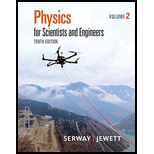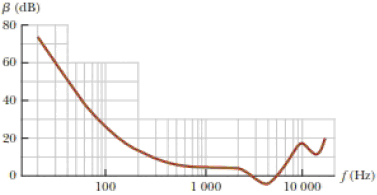
Concept explainers
Ever since seeing Figure 16.22 in the previous chapter, you have been fascinated with the hearing response in humans. You have set up an apparatus that allows you to determine your own threshold of hearing as a function of frequency. After performing the experiment and recording the results, you graph the results, which look like Figure P17.22. You are intrigued by the two dips in the curve at the right-hand side of the graph. You measure carefully and find that the minimum values of these dips occur at 3 800 Hz and 11 500 Hz. Performing some online research, you discover that the outer canal of the human ear can be modeled as an air column open at the outer end and closed at the inner end by the eardrum. You use this information to determine the length of the outer canal in your car.
Figure P17.22

Want to see the full answer?
Check out a sample textbook solution
Chapter 17 Solutions
Physics for Scientists and Engineers, Volume 2
- 5. Three blocks, each with mass m, are connected by strings and are pulled to the right along the surface of a frictionless table with a constant force of magnitude F. The tensions in the strings connecting the masses are T1 and T2 as shown. m T1 T2 F m m How does the magnitude of tension T₁ compare to F? A) T₁ = F B) T₁ = (1/2)F C) T₁ = (1/3)F D) T₁ = 2F E) T₁ = 3Farrow_forwardUsing Coulombs Law, what is the magnitude of the electrical force between two protons located 1 meter apart from each other in Newtons?arrow_forwardCalculate the magnitude of the gravitational force between 2 protons located 1 meter apart from each other in Newtons using Newton's Law of Universal Gravitation.arrow_forward
- If the metal sphere on the Van de Graff has a charge of 0.14 Coulombs and the person has a mass of 62 kg, how much excess charge would the person need in order to levitate at a distance 25 cm from the center of the charged metal sphere if there is a distance 25 cm from the person to the sphere using Coulomb's Law to calculate the electrical force. Give your answer as the number of Coulombs (with no unit label, as usual).arrow_forwardA balloon is rubbed on a sweater, giving the balloon a negative charge by adding an extra 3.9 x 107 electrons compared to its neutral state. What is the magnitude of the net charge on the balloon, in Coulombs?arrow_forwardA ping pong ball and a tennis ball are dropped and there is a very small gap between them when the tennis ball hits the floor. Indicate the directions of the momentums of the ping pong ball and the tennis ball after the tennis ball collides with the floor, but before the balls collide with each other. (Drawing a diagram may be helpful.)arrow_forward
- Describe how the momentum of a single ball changes as it free falls from a height of approximately 1 m, collides with a hard floor, and rebounds.arrow_forwardIf the answer is 2.8, -2.8 or -8.4, it is not CORRECTarrow_forwardThree blocks, light connecting ropes, and a light frictionless pulley comprise a system, as shown in the figure. An external force of magnitude P is applied downward on block A, causing block A to accelerate downward at a constant 2.5 m/s2. The tension in the rope connecting block B and block C is equal to 60 N. (a) What is the magnitude of the force P? (b) What is the mass of block C?arrow_forward
- Current Attempt in Progress In the figure what is the net electric potential at point P due to the four particles if V = 0 at infinity, q = 2.12 fC, and d = 1.75 cm? d Number MI Units +qarrow_forwardCurrent Attempt in Progress In the figure what is the net electric potential at point P due to the four particles if V = 0 at infinity, q = 2.12 fC, and d = 1.75 cm? d Number MI Units +qarrow_forwardA 0.500 kg sphere moving with a velocity given by (2.00î – 2.60ĵ + 1.00k) m/s strikes another sphere of mass 1.50 kg moving with an initial velocity of (−1.00î + 2.00ĵ – 3.20k) m/s. (a) The velocity of the 0.500 kg sphere after the collision is (-0.90î + 3.00ĵ − 8.00k) m/s. Find the final velocity of the 1.50 kg sphere. R = m/s Identify the kind of collision (elastic, inelastic, or perfectly inelastic). ○ elastic O inelastic O perfectly inelastic (b) Now assume the velocity of the 0.500 kg sphere after the collision is (-0.250 + 0.850ĵ - 2.15k) m/s. Find the final velocity of the 1.50 kg sphere. ✓ = m/s Identify the kind of collision. O elastic O inelastic O perfectly inelastic (c) Take the velocity of the 0.500 kg sphere after the collision as (−1.00ỉ + 3.40] + ak) m/s. Find the value of a and the velocity of the 1.50 kg sphere after an elastic collision. (Two values of a are possible, a positive value and a negative value. Report each with their corresponding final velocities.) a…arrow_forward
 Physics for Scientists and EngineersPhysicsISBN:9781337553278Author:Raymond A. Serway, John W. JewettPublisher:Cengage Learning
Physics for Scientists and EngineersPhysicsISBN:9781337553278Author:Raymond A. Serway, John W. JewettPublisher:Cengage Learning Physics for Scientists and Engineers with Modern ...PhysicsISBN:9781337553292Author:Raymond A. Serway, John W. JewettPublisher:Cengage Learning
Physics for Scientists and Engineers with Modern ...PhysicsISBN:9781337553292Author:Raymond A. Serway, John W. JewettPublisher:Cengage Learning Principles of Physics: A Calculus-Based TextPhysicsISBN:9781133104261Author:Raymond A. Serway, John W. JewettPublisher:Cengage Learning
Principles of Physics: A Calculus-Based TextPhysicsISBN:9781133104261Author:Raymond A. Serway, John W. JewettPublisher:Cengage Learning College PhysicsPhysicsISBN:9781305952300Author:Raymond A. Serway, Chris VuillePublisher:Cengage Learning
College PhysicsPhysicsISBN:9781305952300Author:Raymond A. Serway, Chris VuillePublisher:Cengage Learning College PhysicsPhysicsISBN:9781285737027Author:Raymond A. Serway, Chris VuillePublisher:Cengage Learning
College PhysicsPhysicsISBN:9781285737027Author:Raymond A. Serway, Chris VuillePublisher:Cengage Learning College PhysicsPhysicsISBN:9781938168000Author:Paul Peter Urone, Roger HinrichsPublisher:OpenStax College
College PhysicsPhysicsISBN:9781938168000Author:Paul Peter Urone, Roger HinrichsPublisher:OpenStax College





